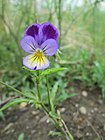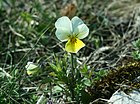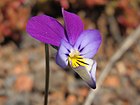Note: This is a project under development. The articles on this wiki are just being initiated and broadly incomplete. You can Help creating new pages.
Difference between revisions of "Viola tricolor"
| (2 intermediate revisions by the same user not shown) | |||
| Line 1: | Line 1: | ||
| − | + | [[File:Viola tricolor LC0041.jpg|thumb|right]] | |
| + | '''Viola tricolor''' is a very variable, annual to perennial plant with erect stems 10 - 40cm tall. The plant is harvested from the wild for local use as a food, medicine and source of a dye. It is sometimes grown as an ornamental in the garden. | ||
==Uses== | ==Uses== | ||
| − | {{Uses|}}, {{Uses|}}, {{Uses|}}, {{Uses|}}, {{Uses|}}, {{Uses|}}, {{Uses| | + | {{Uses|Epilepsy}}, {{Uses|Eczema}}, {{Uses|Skin diseases}}, {{Uses|Whooping cough}}, {{Uses|Rheumatism}}, {{Uses|Cystitis}}, {{Uses|Eczema}}.<ref name="Uses"/> |
==Parts Used== | ==Parts Used== | ||
| − | {{Parts Used| | + | {{Parts Used|Young leaves}}, {{Parts Used|Flower buds}}. |
==Chemical Composition== | ==Chemical Composition== | ||
| − | <ref name="chemical composition"/> | + | It contains the methanolic extract of Viola tricolor has been investigated for their flavonoid contents through LC-MS, HPLC and NMR and five minor flavonoids were identified.<ref name="chemical composition"/> |
==Common names== | ==Common names== | ||
| Line 16: | Line 17: | ||
===Dravya=== | ===Dravya=== | ||
===Rasa=== | ===Rasa=== | ||
| − | |||
===Guna=== | ===Guna=== | ||
| Line 29: | Line 29: | ||
==Habit== | ==Habit== | ||
| − | {{Habit|}} | + | {{Habit|Perennial}} |
==Identification== | ==Identification== | ||
| Line 48: | Line 48: | ||
==Mode of Propagation== | ==Mode of Propagation== | ||
| − | {{Propagation|}} | + | {{Propagation|Seeds}} |
==How to plant/cultivate== | ==How to plant/cultivate== | ||
| − | <ref name="How to plant/cultivate"/> | + | Prefers a cool moist well-drained humus-rich soil in partial or dappled shade and protection from scorching winds.<ref name="How to plant/cultivate"/> |
==Commonly seen growing in areas== | ==Commonly seen growing in areas== | ||
| − | {{Commonly seen|}}, {{Commonly seen| | + | {{Commonly seen|Waste ground}}, {{Commonly seen|Short grassland}}. |
==Photo Gallery== | ==Photo Gallery== | ||
| Line 61: | Line 61: | ||
20160421Viola tricolor1.jpg | 20160421Viola tricolor1.jpg | ||
20180612Viola tricolor1.jpg | 20180612Viola tricolor1.jpg | ||
| − | |||
| − | |||
20180612Viola tricolor2.jpg | 20180612Viola tricolor2.jpg | ||
| − | |||
| − | |||
1224-Viola tricolor ssp. saxatilis-Pálava 4.07.jpg | 1224-Viola tricolor ssp. saxatilis-Pálava 4.07.jpg | ||
| − | |||
| − | |||
1240-Viola tricolor ssp. saxatilis-Pálava 4.07.jpg | 1240-Viola tricolor ssp. saxatilis-Pálava 4.07.jpg | ||
| − | |||
| − | |||
20160421Viola tricolor2.jpg | 20160421Viola tricolor2.jpg | ||
| − | |||
| − | |||
20160421Viola tricolor3.jpg | 20160421Viola tricolor3.jpg | ||
| − | |||
| − | |||
AK 00784 Stiefmütterchen Sandloch Winterthur.tif | AK 00784 Stiefmütterchen Sandloch Winterthur.tif | ||
| − | |||
</gallery> | </gallery> | ||
| Line 85: | Line 72: | ||
<references> | <references> | ||
| − | <ref name="chemical composition">[ | + | <ref name="chemical composition">[https://scialert.net/fulltext/?doi=crc.2015.44.52#:~:text=The%20methanolic%20extract%20of%20Viola%20tricolor%20has%20been%20investigated,et%20al.%2C%202008a).&text=Viola%20odorata%20contains%20alkaloids%2C%20glycosides,C%20(Stuart%2C%201989). Chemical constituents]</ref> |
| − | <ref name="Leaf">[ | + | <ref name="Leaf">[Morphology]</ref> |
| − | <ref name="How to plant/cultivate">[ | + | <ref name="How to plant/cultivate">[http://temperate.theferns.info/plant/Viola+tricolor Cultivation]</ref> |
<ref name="Uses">Indian Medicinal Plants by C.P.Khare</ref> | <ref name="Uses">Indian Medicinal Plants by C.P.Khare</ref> | ||
</references> | </references> | ||
==External Links== | ==External Links== | ||
| − | * [ ] | + | * [https://plants.ces.ncsu.edu/plants/viola-tricolor/ Viola tricolor on plants.ces.ncsu.edu] |
| − | * [ ] | + | * [https://pfaf.org/user/plant.aspx?latinname=Viola+tricolor Viola tricolor on pfaf.org] |
| − | + | ||
[[Category:Herbs]] | [[Category:Herbs]] | ||
Latest revision as of 18:00, 2 September 2020
Viola tricolor is a very variable, annual to perennial plant with erect stems 10 - 40cm tall. The plant is harvested from the wild for local use as a food, medicine and source of a dye. It is sometimes grown as an ornamental in the garden.
Contents
- 1 Uses
- 2 Parts Used
- 3 Chemical Composition
- 4 Common names
- 5 Properties
- 6 Habit
- 7 Identification
- 8 List of Ayurvedic medicine in which the herb is used
- 9 Where to get the saplings
- 10 Mode of Propagation
- 11 How to plant/cultivate
- 12 Commonly seen growing in areas
- 13 Photo Gallery
- 14 References
- 15 External Links
Uses
Epilepsy, Eczema, Skin diseases, Whooping cough, Rheumatism, Cystitis, Eczema.[1]
Parts Used
Chemical Composition
It contains the methanolic extract of Viola tricolor has been investigated for their flavonoid contents through LC-MS, HPLC and NMR and five minor flavonoids were identified.[2]
Common names
| Language | Common name |
|---|---|
| Kannada | |
| Hindi | |
| Malayalam | |
| Tamil | |
| Telugu | |
| Marathi | |
| Gujarathi | |
| Punjabi | |
| Kashmiri | |
| Sanskrit | |
| English |
Properties
Reference: Dravya - Substance, Rasa - Taste, Guna - Qualities, Veerya - Potency, Vipaka - Post-digesion effect, Karma - Pharmacological activity, Prabhava - Therepeutics.
Dravya
Rasa
Guna
Veerya
Vipaka
Karma
Prabhava
Habit
Identification
Leaf
| Kind | Shape | Feature |
|---|---|---|
Flower
| Type | Size | Color and composition | Stamen | More information |
|---|---|---|---|---|
| {{{5}}} |
Fruit
| Type | Size | Mass | Appearance | Seeds | More information |
|---|---|---|---|---|---|
Other features
List of Ayurvedic medicine in which the herb is used
Where to get the saplings
Mode of Propagation
How to plant/cultivate
Prefers a cool moist well-drained humus-rich soil in partial or dappled shade and protection from scorching winds.[4]
Commonly seen growing in areas
Waste ground, Short grassland.
Photo Gallery
References
- ↑ Indian Medicinal Plants by C.P.Khare
- ↑ Chemical constituents
- ↑ [Morphology]
- ↑ Cultivation
External Links
- Ayurvedic Herbs known to be helpful to treat Epilepsy
- Ayurvedic Herbs known to be helpful to treat Eczema
- Ayurvedic Herbs known to be helpful to treat Skin diseases
- Ayurvedic Herbs known to be helpful to treat Whooping cough
- Ayurvedic Herbs known to be helpful to treat Rheumatism
- Ayurvedic Herbs known to be helpful to treat Cystitis
- Herbs with Young leaves used in medicine
- Herbs with Flower buds used in medicine
- Habit - Perennial
- Index of Plants which can be propagated by Seeds
- Herbs that are commonly seen in the region of Waste ground
- Herbs that are commonly seen in the region of Short grassland
- Herbs









